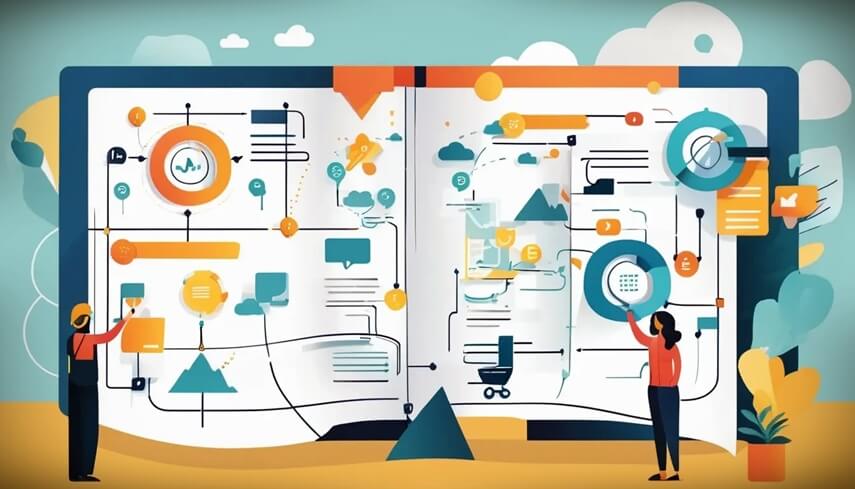Customer Journey Mapping has become a cornerstone for businesses seeking to enhance customer experience and optimize conversions. But mapping a seamless path from initial contact to purchase and beyond isn’t always straightforward. Enter AI, the game-changer that revolutionizes how businesses understand and cater to their customers. With customer experience mapping and journey mapping tools, organizations can now pinpoint customer pain points, refine touchpoint optimization, and create a cohesive experience that drives loyalty and revenue.
In this comprehensive guide, we’ll delve into the nuances of customer journey mapping, explore the role of AI in customer behavior insights, and equip you with actionable strategies to transform your customer journeys.
Understanding Customer Journey Mapping
What is Customer Journey Mapping?
At its core, customer journey mapping is the process of visualizing and analyzing the steps a customer takes when interacting with a brand. It includes every phase, from discovering a product to making a purchase and beyond, encompassing the full customer lifecycle stages.
By leveraging user journey analysis and creating customer personas, businesses can identify key customer touchpoints and evaluate how they influence decision-making. This visualization often highlights areas where the journey falters, providing opportunities for improvement.
Why Is Customer Journey Mapping Crucial?
- Enhances Customer Experience: A well-crafted journey map ensures seamless interactions at every stage, improving the end-to-end customer experience.
- Identifies Customer Pain Points: Pinpointing challenges helps businesses proactively address barriers to conversion.
- Optimizes Engagement: Understanding the journey allows for touchpoint optimization, ensuring each interaction is meaningful and effective.
- Boosts Retention: A well-defined journey map facilitates customer retention strategies by building loyalty through personalized experiences.
The Role of AI in Customer Journey Mapping
AI-Powered Insights for Enhanced Mapping
Artificial Intelligence (AI) has revolutionized customer journey analytics by providing deep insights into customer behavior. By analyzing vast amounts of data, AI identifies patterns and trends that might otherwise go unnoticed.
- Customer Behavior Insights: Machine learning models analyze customer interactions to predict behaviors, preferences, and purchasing habits.
- Sales Funnel Mapping: AI tools highlight drop-off points within the sales funnel, helping businesses refine their strategies.
- Customer Feedback Integration: AI-powered sentiment analysis tools process customer reviews and feedback, offering valuable input for journey mapping.
Benefits of Using AI in Journey Mapping
- Scalability: AI can analyze massive datasets efficiently, making it ideal for large-scale businesses.
- Precision: By using predictive analytics, AI ensures that customer journeys are tailored to individual needs.
- Real-Time Adjustments: AI enables dynamic adjustments to the journey based on real-time customer interactions.
Steps to Master Customer Journey Mapping
Step 1: Define Customer Personas
Understanding who your customers are is the foundation of effective customer experience mapping. Leverage empathy mapping and AI-driven tools to create detailed profiles that include demographics, behaviors, and goals.
Step 2: Identify Customer Touchpoints
List all the places where customers interact with your brand, including websites, social media, emails, and physical stores. Use omnichannel journey mapping to ensure these touchpoints are cohesive across platforms.
Step 3: Analyze the Current Journey
Conduct a thorough user journey analysis using AI-powered journey mapping tools. Identify gaps, redundancies, and pain points that could disrupt the flow.
Step 4: Optimize Touchpoints
Focus on touchpoint optimization to streamline interactions and enhance satisfaction. Prioritize areas where customers experience delays or confusion.
Step 5: Incorporate AI for Personalization
Leverage AI to tailor customer journeys. For example, use predictive analytics to recommend products or services based on past behaviors.
Tools and Techniques for Customer Journey Mapping
Top AI-Driven Tools for Mapping
- Google Analytics: For tracking customer behavior across digital touchpoints.
- HubSpot: Offers comprehensive journey mapping and customer lifecycle stage analysis.
- Qualtrics: Ideal for customer feedback integration and satisfaction metrics.
- Zendesk: Helps analyze support-related interactions for customer retention strategies.
Best Practices for Success
- Focus on Data: Use AI to gather accurate, real-time data for more precise journey maps.
- Keep the Customer at the Center: Regularly update maps to reflect evolving customer needs.
- Collaborate Across Teams: Align marketing, sales, and customer support teams to ensure a unified approach.
Measuring Success in Customer Journey Mapping
Key Metrics to Monitor
- Customer Satisfaction Metrics: Measure how customers perceive their journey.
- Conversion Rates: Track improvements in key touchpoints that drive sales.
- Retention Rates: Monitor repeat purchases and long-term loyalty.
Continuous Improvement with AI
AI facilitates a dynamic approach to mapping. By continuously analyzing data, businesses can adapt their strategies to stay ahead of changing customer expectations.
Conclusion
Customer journey mapping is no longer just a theoretical exercise, it’s a strategic imperative. By integrating AI, businesses can go beyond traditional methods, using customer journey analytics and user journey analysis to deliver a seamless, personalized experience. From identifying customer pain points to enhancing touchpoint optimization, AI empowers businesses to build journeys that not only convert but also retain loyal customers.
Start leveraging AI in your customer journey mapping strategy today, and pave the way for an optimized, data-driven future in customer experience.




